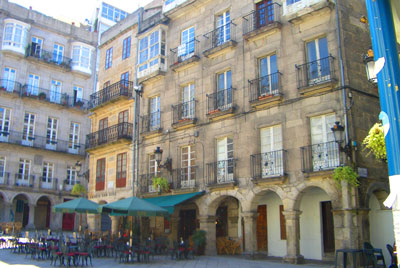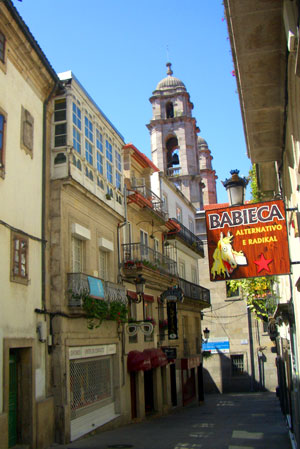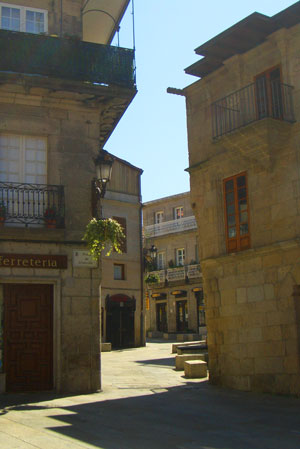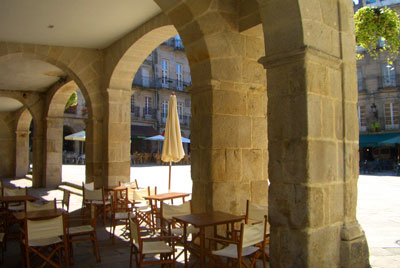The old town of Vigo
Based around the original fishermen's houses and located on the slopes leading down to Vigo's earliest port, the city's old quarter is extremely underrated and actually a small treasure. Amazingly most guides do not even mention Vigo's old district, but it is there and it is definitely worth
 seeing.
seeing.
This part of the town existed long before Vigo attained its present population and city status, but like the original town walls, part of the district was demolished to make way for newer developments.
Despite "new" Vigo's advance, the old quarter (running down to what is now the marina) still retains many of its original buildings with the "Iglesia Concatedral de Santa Maria" (church) very much at its center.
Translated as the "Collegiate church of Saint Maria", this is the oldest of the city's churches and what remains of the original town radiates away from it on streets like the "Rua Real" and the "Triunfo". Some of these streets are connected by the narrowest of alleys and others have incredibly steep flights of steps leading away from them and down to the port area. Some of these stairs are so steep and narrow that few would consider using them today.
The historic district of Vigo
A hundred years earlier this old quarter would have been much larger, but even now many of the buildings that formed the nucleus of the district are
 still standing. So too are four of the original squares, numbering the "plaza de Pedra", immediately below St. Maria's church, the "plaza Almeida", just above the church, along with the "plaza Princesa" and the largest of the four, the "plaza Constitucion".
still standing. So too are four of the original squares, numbering the "plaza de Pedra", immediately below St. Maria's church, the "plaza Almeida", just above the church, along with the "plaza Princesa" and the largest of the four, the "plaza Constitucion".
All of these squares are atmospheric and overlooked by the original buildings of the area and the latter two have the addition of tables and chairs from the café culture that now thrives in this area.
Walking around the old town is definitely an experience and any visitor will be surprised that such a place still exists in the vast metropolis that is Vigo. But the old quarter is far from dead and in the area around the Pedra square there is a market along with ladies selling the traditional oysters of the locality. These oysters are presented on boxes and benches and the shells cracked open when you make your order.
The levels of renovation in Vigo's old town do vary and whilst most of this district is in excellent condition, there are some small areas that are presently (July 2007) being refurbished. These areas are however small and do not detract from the character of the neighbourhood.
In days gone by a small part of the old town, in the vicinity of the Pedra square, was a meeting point for smugglers and as you walk down these narrow lanes it is easy to see why. Very few streets are straight and all seem to have projections or hidden alleys at every bend. It would have been easy for smugglers to evade those trying to enforce the law, especially outside daylight hours.
During the day these winding streets can offer much appreciated shade from the sun, but at night they must take on a totally different and much more eerie feel. The smugglers are definitely gone, but their shadows still remain.
An old town with plenty to see
The scale of the buildings in the old town should not be underestimated, nor should the variety of building in this historic district. Although some of the original fishing houses still comprise this area,
 this was the first real settlement of Vigo and there are a significant number of much larger and grander structures to see.
this was the first real settlement of Vigo and there are a significant number of much larger and grander structures to see.
The four plazas in particular are overlooked by some large stone buildings of four and five storeys in height and some of these are of classic Galician design with arched walkways at ground level and balconies on the preceding floors. The more recent building too have adopted similar aesthetics ensuring that this special area loses nothing of its old world charm.
Probably the most important street in old Vigo is, or at least once was, "Rua Real". Running from the church of Maria to the site of the first port, this is the street on which most of the remaining fishermen's houses can now be found. The oldest of these properties date back to the sixteen hundreds while the more recent examples were constructed in the nineteenth century. It is also from the Rua Real that a number of incredibly steep flights of stone stairs descend down and approach the port.
It would be wrong to overstate the size of Vigo's old town, but despite is small stature it is well worth visiting.
Wondering around the narrow streets and then seeing one of them open up onto an unexpected plaza is something that few cities on Vigo's scale can still offer. This town also has genuine atmosphere and with its cafes and the marina never more than a few strides away it is not to be missed.

Left, looking through the stone archways at one of the squares and its numerous cafes in the old district.

